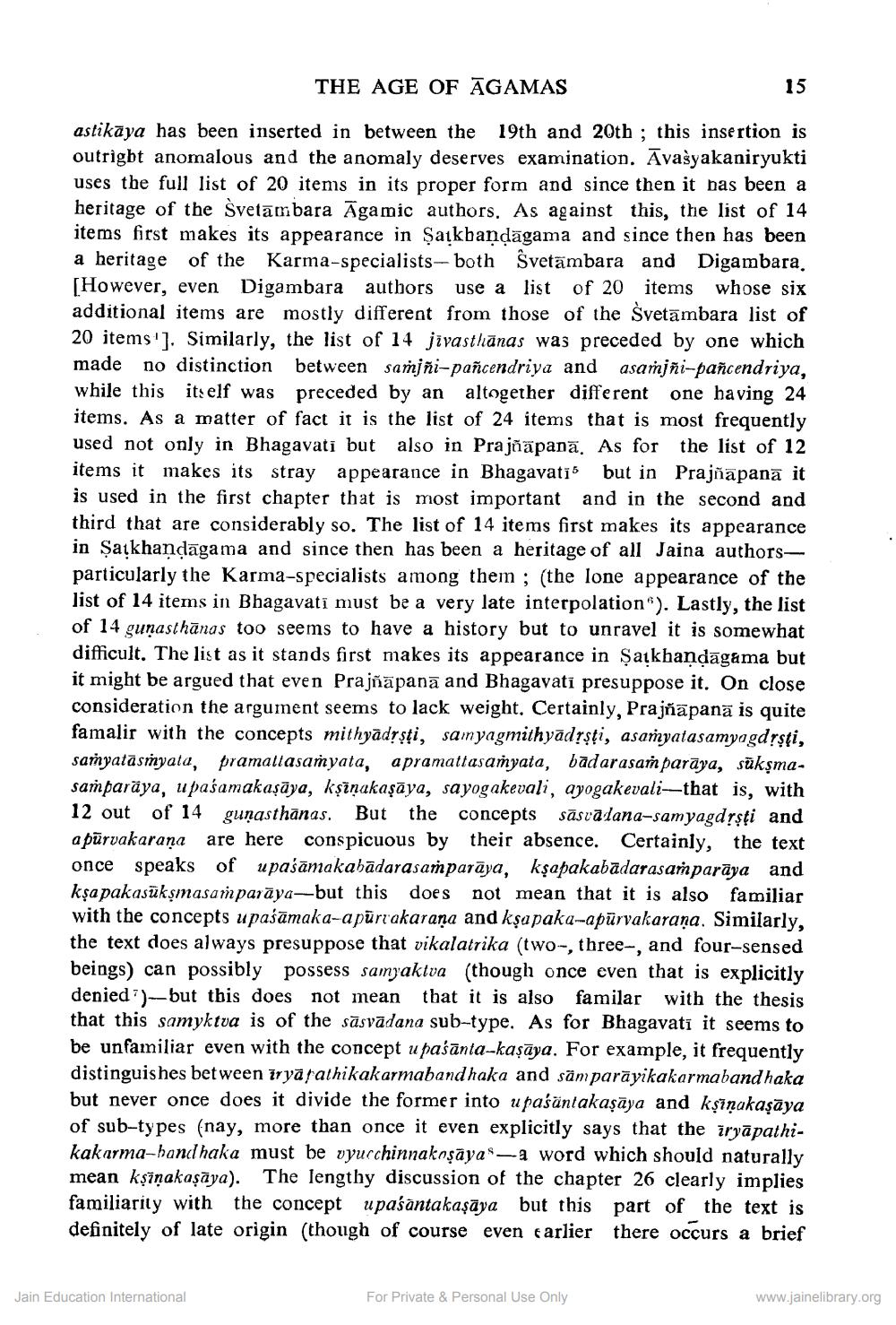________________
THE AGE OF AGAMAS
15
astikaya has been inserted in between the 19th and 20th ; this insertion is outright anomalous and the anomaly deserves examination. Avašyakaniryukti uses the full list of 20 items in its proper form and since then it has been a heritage of the Svetāmbara Āgamic authors. As against this, the list of 14 items first makes its appearance in Şaikbandāgama and since then has been a heritage of the Karma-specialists, both Svetāmbara and Digambara. [However, even Digambara authors use a list of 20 items whose six additional items are mostly different from those of the Svetāmbara list of 20 items']. Similarly, the list of 14 jivasthānas was preceded by one which made no distinction between samjñi-pañcendriya and asamjñi-pañcendriya, while this itself was preceded by an altogether different one having 24 items. As a matter of fact it is the list of 24 items that is most frequently used not only in Bhagavati but also in Prajāapanā. As for the list of 12 items it makes its stray appearance in Bhagavatī5 but in Prajña pana it is used in the first chapter that is most important and in the second and third that are considerably so. The list of 14 items first makes its appearance in Satkhandagama and since then has been a heritage of all Jaina particularly the Karma-specialists among them ; (the lone appearance of the list of 14 items in Bhagavati must be a very late interpolation"). Lastly, the list of 14 gunasthānas too seems to have a history but to unravel it is somewhat difficult. The list as it stands first makes its appearance in Sakhandāgama but it might be argued that even Prajñāpanā and Bhagavati presuppose it. On close consideration the argument seems to lack weight. Certainly, Prajñāpanā is quite famalir with the concepts mithyādęsti, samyagmithyādīşti, asamyatasamyagdrsti, samyatāsmyata, pramaltasaṁyata, apramattasamyata, badarasam parāya, sūkşmasamparāya, upaśamakaṣāya, kşīņakaṣāya, sayogakevali, ayogakevali—that is, with 12 out of 14 gungsthānas. But the concepts sāsvādana-samyagdrşți and a pūrvakaraņa are here conspicuous by their absence. Certainly, the text once speaks of upašāmakabādarasamparāya, kşapakabadarasamparāya and kṣa pakasükşinasamparāya--but this does not mean that it is also familiar with the concepts upašāmaka-apurrakarana and kşapaka-apūrvakarana. Similarly, the text does always presuppose that vikalatrika (two-, three-, and four-sensed beings) can possibly possess samyaktva (though once even that is explicitly denied)--but this does not mean that it is also familar with the thesis that this samyktva is of the sāsvādana sub-type. As for Bhagavati it seems to be unfamiliar even with the concept u paśānta-kaṣāya. For example, it frequently distinguishes between irya fathikakarmabandhaka and sämparāyikakarmaband haka but never once does it divide the former into upaśäntakaṣāya and kşiņakaşāya of sub-types (nay, more than once it even explicitly says that the iryāpathikakarma-hand haka must be vyucchinnaknṣāyama word which should naturally mean kşīņakaṣāya). The lengthy discussion of the chapter 26 clearly implies familiarity with the concept upaśāntakaṣāya but this part of the text is definitely of late origin (though of course even earlier there occurs a brief
Jain Education International
For Private & Personal Use Only
www.jainelibrary.org




